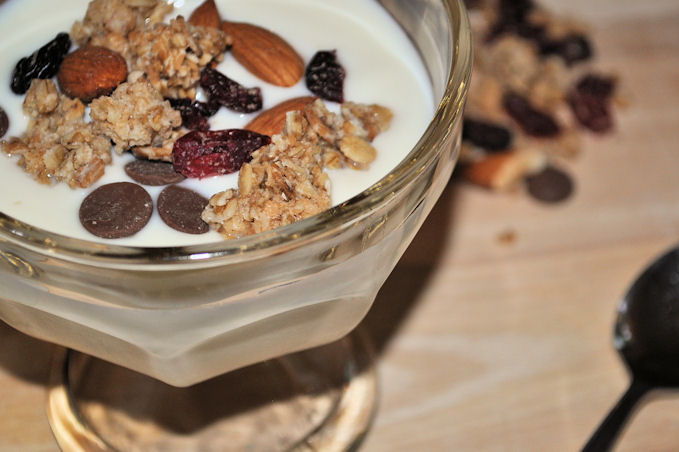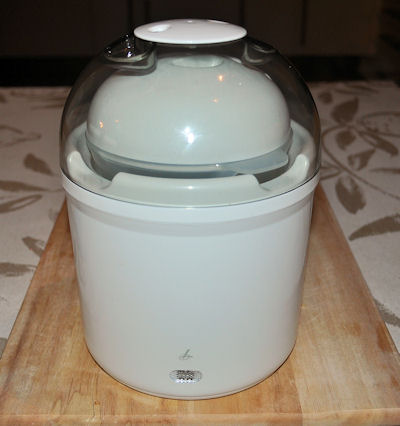
I thought it was about time to do this since I’ve talked but not really gone into depth about how to do it on Twitter, or how it works. Making yoghurt at home is easy and really quite simple. I wish I had done it years ago as it would have saved me a small fortune in lunch boxes.
I’ve certainly cheated by using a yoghurt machine, but how easy it is to have home-made yoghurt is ridiculous.
I bought my yoghurt machine from Lakeland, and it isn’t a bad price considering there isn’t any more outlay once you’ve bought it. I did consider the Easiyo one. Looking looking at the stats, it might have been cheaper initially, but it would have needed endless topping up of their sachet systems to make yoghurt with, and I thought those were very expensive.
Ok, ok, I know you just want to get into finding out how to make yoghurt, and miss out my long-winded explanations.
I was slightly apprehensive about getting my machine as I thought it would be more hit and miss, but it really was very very easy. For this recipe, I sprinkled Granola on the top.

Ingredients
Method
- Switch on yoghurt maker to warm up before you start.
- Put 1 litre of milk into a jug or the dish for the yoghurt maker. I have used UHT versions of milk as to use non UHT means that it would need to be heated up. Keep UHT milk at room temperature and not in the fridge, unless it has already been opened..
- Optional: Heat the milk gently in the microwave for a minute to take the edge off how cold the milk is.
- Stir the milk, and add the live culture and skimmed milk powder.
- Stir thoroughly and place the lid of the yoghurt maker on.
- Leave for 8 hours and come back to lovely thick yoghurt.
- Put straight in the fridge to chill for later.
- When chilled, add any sugar, fruit or spice to taste, it can also be used for cooking.
Notes










I do exactly as you have done for several years now. I find full fat UHT and powdered milk makes the best thick creamy yoghurt. I add it to frozen fruits for dessert with a sprinkling of Truvia granules for taste. Grandchildren love it mixed with a spoonful of runny honey.
Possibly a daft question but if you want to make a smaller quantity – same times? So would 500ml milk, 1 ts of culture and 8 hours in the machine work or am I going to overdo it?
We have to go by our machines. Fermenting time seems to be the same, for whatever quantity of milk I’ve used. I think sometimes, the only way to know, is to try it. That’s how I found out soupmakers and porridge just don’t mix…..
you say that you have used uht milk to make yoghurt ,a nd that you use it at room temp. does the uht yoghurt taste differently from fresh milk. it certainly would be handier than heating to boiling point and then cooling.
It doesn’t taste any different to me so I keep using UHT as it’s simpler for me.
Using a Lakeland yogurt maker & ‘Straight Up’ yogurt, sold by Waitrose, as a starter culture plus dried milk to date each batch I have made has been semi liquid. Is this because I have used low fat goats milk or the culture used.
What culture do you use assuming this is my problem.
Sorry. I have no idea, as I’ve never made yoghurt with dried milk. The yogurt can be thinner than expected sometimes though. I tend to use Yeoville, or a thick live yog. I find a few hours in the fridge tends to help mine along a bit once made. It’s trial and error sometimes, although perhaps, depending on how much milk you added, it could do with a little less to allow it to thicken up.
Thanks …very useful article, but in the second last sentence I think you meant to say “if you are using unpasteurised milk, ensure you heat it up to boiling point”
Well spotted. Thanks.
Hi there! This article coul nnot be writen much better!
Reading through this article reminds me of my previos roommate!
He constantly kept preaching about this. I am going to send this information to him.
Fairly certain he’ll have a great read. Thanks for sharing!
I love homemade yogurt. But if new live cultures is not added each time in producing yogurt, the many benefits of the different bacteria are not kept. So i use Nutriflora culture, as it is the best one i have tried for making the best Gourmet yogurt.
I’m really tempted to buy a yogurt maker now. Will pop over to try yours.
Next post should be on how to make yogurt without yogurt maker 😛
Nah.. Just kidding 🙂
Cracking, thanks.